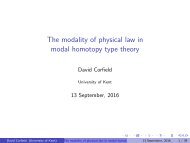TOMBO Ver.2 Manual
TOMBO
TOMBO
Create successful ePaper yourself
Turn your PDF publications into a flip-book with our unique Google optimized e-Paper software.
1.3 All-electron charge density and potential 8<br />
all the contributions from surrounding atoms. This summation should be taken not only<br />
inside the own unit cell, but also surrounding or further apart unit cells. To treat this accurately,<br />
we use the following Fourier decoupling method. In this method, the simple potential<br />
form −Z ∗ j /r j given by Eq.(1.24) connects smoothly to the quadratic function inside the nonoverlapping<br />
atomic sphere. They should have the same value and the same derivative at the<br />
radius of the atomic sphere r = r c :<br />
⎧<br />
⎨<br />
v interpo Z ∗ j<br />
j<br />
(r j ) =<br />
(br2 j + d) for r j < r c ,<br />
⎩−Z ∗ j /r j for : r j ≥ r c .<br />
From the matching condition, we obtain<br />
(1.25)<br />
br 2 c + d = −1/r c , 2br c = 1/r 2 c. (1.26)<br />
From simple calculation, we find that these conditions are identical to<br />
b = 1<br />
2rc<br />
3 , d = − 3 . (1.27)<br />
2r c<br />
Thus connected potential is a smooth and analytic function over whole space and is easily<br />
transformed into reciprocal lattice space analytically. We call this potential the interpolated<br />
Coulomb potential and write it as v interpo<br />
j<br />
(r j ); see Eq.(1.25). This interpolated Coulomb<br />
potential takes the correct value of the Coulomb potential, v H j (r j) − Z j<br />
r j<br />
, everywhere outside<br />
the jth atomic sphere; It takes an incorrect value only inside the jth atomic sphere, and its<br />
difference from the correct value is given by<br />
Vj<br />
trunc (r j ) = v H j (r j ) − Z j<br />
− v interpo<br />
j<br />
(r j ), (1.28)<br />
r j<br />
which we call the truncated Coulomb potential. It has nonzero values only each atomic<br />
sphere, and is spherically symmetric. This truncation is schematically illustrated in Fig.1.4.<br />
This truncated Coulomb potential is added to the truncated spherical exchange-correlation<br />
potential µ xc<br />
j (|r − R j |) and stored as one-dimensional data on the radial logarithmic mesh.<br />
Apart from this truncated function, we have to treat separately interpolated Coulomb<br />
potential v interpo<br />
j<br />
(r j ). This function v interpo<br />
j<br />
(r j ) is analytically expressed by Eq.(1.25) in infinite<br />
space, and therefore is able to be analytically transformed into G space. The Fourier<br />
coefficients are explicitly given by<br />
{<br />
¯v interpo<br />
j<br />
(G) = 4πZ je −iG·R j<br />
b [( 3(Gr c ) 2 − 6 ) ]<br />
sinGr c + 6Gr c cosGr c /G<br />
5<br />
Ω



